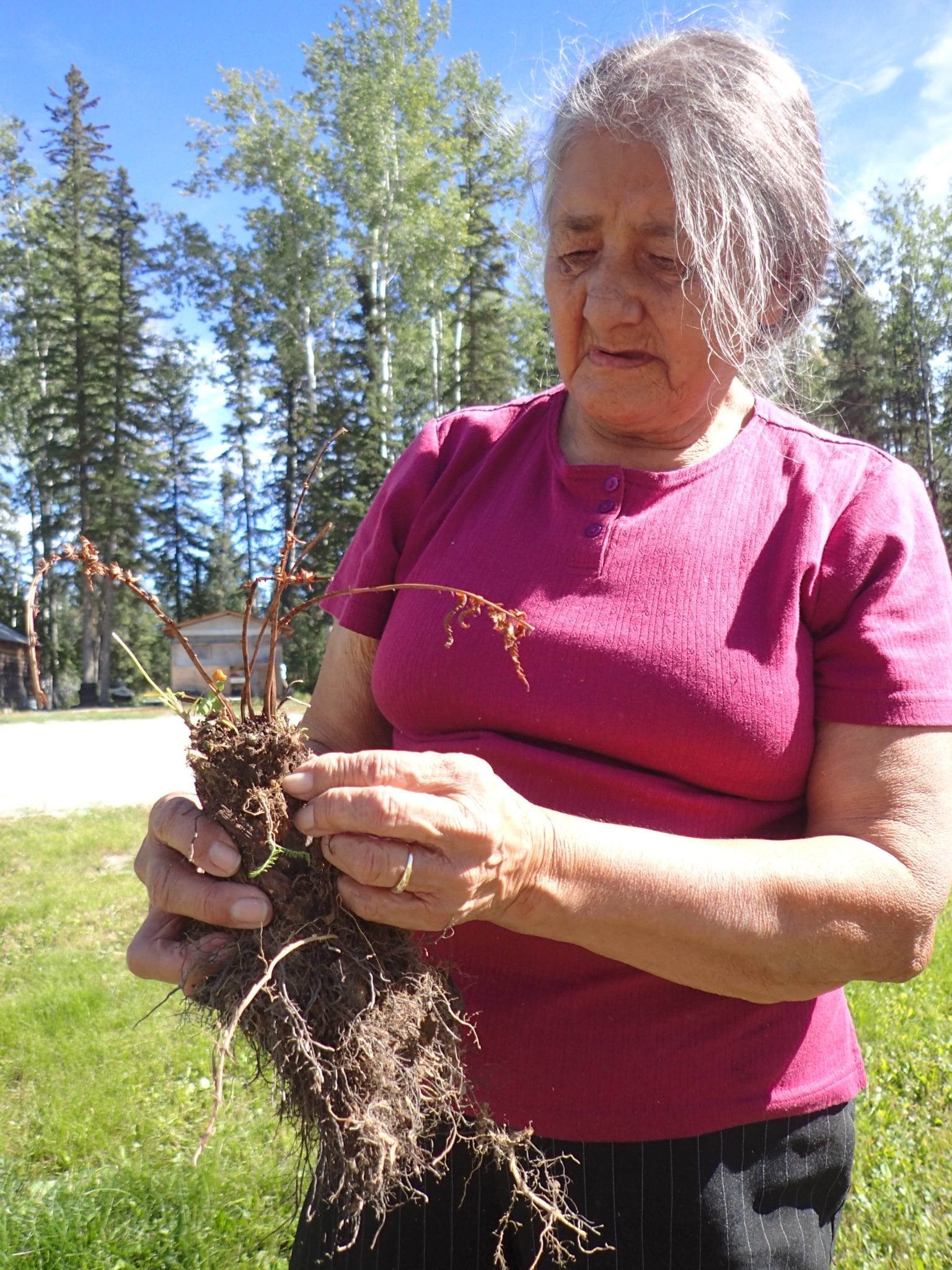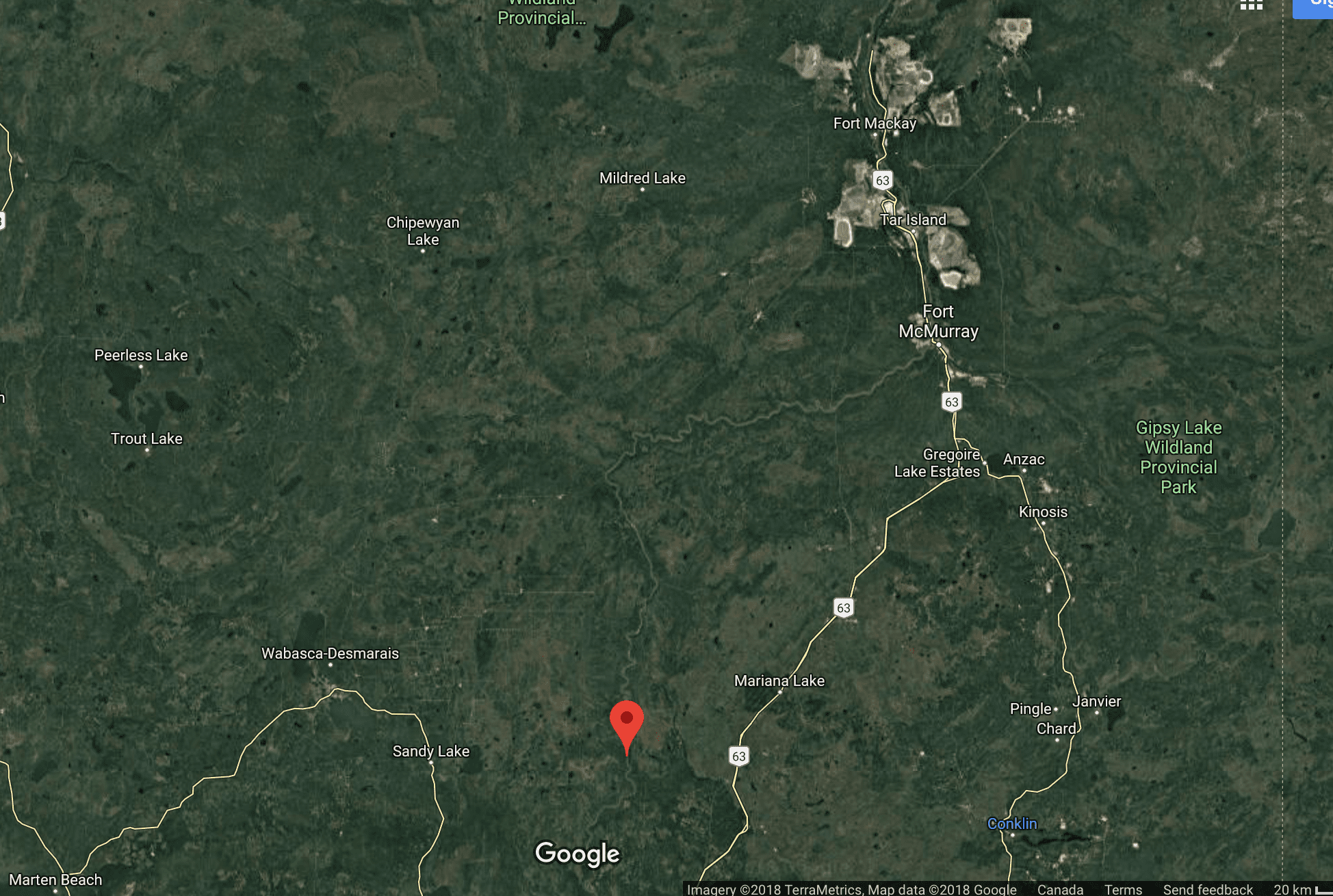Janelle Baker
Alberta, Canada
Introduction: the big flame
 |
|
Figure 1. Virginia Stewart holding Dryopteris expansa at Pelican Portage |
Elder Virginia Stewart from Bigstone Cree Nation crouched down near her family’s derelict home to pull out a “spreading wood fern” or “broad spinulose shieldfern” (Dryopteris expansa) (see Turner et al. 1992) frond and fresh roots, going out of her way to show me the fern that can “make you fat” (Figure 1). Called “wiyinohwask” (fat root) in sakaw nehiyawewin (the Northern Bush Cree language), Virginia explained that you take the rhizome or rootstock, a scaly pineapple-like structure (Figures 2 and 3), scrub, dry, and grind it and then eat it with salt and pepper as a seasoning, and it will make you gain weight.1 I was with Virginia, her husband Jeremy, Elder Mike Beaver, and a group of Bigstone Cree Nation environmental monitors at the abandoned settlement at Pelican Portage on the west side of the Athabasca River, south of the open-pit oil sands mines near Fort McMurray, in 2009.
Bigstone Cree Nation is a sakâwiyiniwak (Northern Bush Cree) community in northern Alberta, Canada, situated on top of the eastern edges of the infamous Athabasca oil sands deposit. We had traveled down river, as a part of traditional land use research that we were doing for the First Nation. Pelican Portage used to be an important settlement where the Pelican River meets the Athabasca River (Figure 4). Mike Beaver, a band Councilor, former Chief, and spiritual Elder in the community had requested that we take the two Elders, Virginia and Jeremy Stewart, to the Pelican Portage Settlement because they had lived there before moving to the Bigstone Cree Nation small “pocket” reserve at Sandy Lake. I can only imagine what this trip meant to the Stewarts, who had not been back to this place for at least forty years, where they had a home, their first children were born, and their family members were buried. Almost the entire population of the Pelican Portage Settlement moved to the Sandy Lake reserve when children were forced to go to residential school.
 |
|
|
Figure 2. Dryopteris expansa rhizome |
|
Pelican Portage has an unusual story that I first heard while we camped nearby. In sakaw nehiyawewin, they call the place kakwahkotihk (place with big flames) after a natural gas flare, where people say that the “gas just came out of the ground.” It turns out that Geological Survey of Canada geologists did some exploratory drilling for oil at Pelican Rapids in 1897 and at 250 meters below the surface they struck natural gas, the well blew out of control, and was not capped until 1919 (Wetherell and Kmet 2000:31). The geologists had believed that the bituminous oil sands, visible from the Athabasca River banks, were part of an “upwelling” of large pools of oil that could be accessed through conventional drilling (Wetherell and Kmet 2000:31). They instead found natural gas in the test well, and it blew water, rocks, and gas out of it that the drilling crew thought would eventually “blow off” if they left it alone for the winter (Court 1973). The drilling crew returned in 1898, but when they cleaned out the drilling hole, it again blew dust, rocks, and gas into the air higher than the derrick, so the crew abandoned the well, their equipment, and left the gas to “blow wild” and occasionally lit the gas to flare it off (Court 1973). For over two decades, it was said that you could hear the roar of the billowing and burning gas from the natural gas at the Pelican Portage well flare at least two kilometers away. In 1901, the Edmonton photographer Charles Mathers passed by while traveling the Athabasca River on his way to the Arctic, and the flare was still about nine meters high (Wetherell and Kmet 2000:31). Apparently, sakâwiyiniwak would come and camp near the flare in the winter, presumably for the warmth.
Eating fern rhizomes
 |
|
Figure 3. Virginia Stewart holding Dryopteris expansa rhizome |
While my first encounters with Virginia and the fern occurred in 2009, I returned to visit and learn from Virginia at her home in Sandy Lake in the summer of 2015. Sandy Lake is a place that is facing dramatic landscape disruption due to oil extraction through pollution, deforestation, and water loss. Virginia was excited that someone else had an appreciation for the fern, so she took me to her yard where she had transplanted it. She gave me sections to use as an herbarium specimen as well as one of the scaly, woody, pineapple-like rhizomes. She referred me to nearby places where it grows in the bush, including near a creek and a hilly area called kapaskwahtinahk (Bald Hill). Virginia, now in her 80s, only speaks her language, sakaw nehiyawewin, so her daughter Marlene Stewart, who was also present in 2009 and has become a friend and research collaborator, came along and translated.
Virginia was shown wiyinohwask, or “the fern that makes you fat” by her mother-in-law after she gave birth to her first child, Marlene, because Virginia was too thin. Virginia has always kept the fern rhizome nearby and cared for the plant ever since. She likes to sprinkle the seasoning she prepares onto her soup. She told me you can collect the root anytime of the year that you need it, but it is easier when you can see the leaves and the ground is not frozen (see also Young 2015). Evelyn Vicky Siegfried, an ethnobotanist, archaeologist, and member of Bigstone Cree Nation, wrote in her master’s thesis that the spreading wood fern is eaten by sakâwiyiniwak as a vegetable, and by using the tender shoots “to restore an appetite” (Siegfried 1994:124). I checked with Virginia to see if she eats the young shoots or fiddleheads, and she said no, just the roots. Siegfried also notes that D. expansa roots are used in combination with other plants to cure cancer (Siegfried 1994:120). Dryopteris rhizomes are also used medicinally as an anti-parasitic treatment, as they contain an oleoresin that paralyzes intestinal worms, which can then be expelled from the body with a saline laxative (Marles et al. 2008:79, MacKinnon et al. 2009:380). This could very well explain why D. expansa helps a person to gain weight.
The value of fat
 |
|
| Figure 4. Map of Pelican Portage and Sandy Lake |
My research collaborators and friends from Bigstone Cree Nation place a high value on eating various types of fat, such as moose, bear, fowl, and fish fat, and using it as a medicine. Moose that are fat are highly desirable to hunt, and people will describe how fat a moose was that they butchered long before they consider mentioning how large the animal was.2 It is a real treat to snack on dried moose meat dipped in rendered moose fat, served with salt and bannock. People also eat “Indian popcorn” as a treat, which are fried small pieces of moose fat and meat. Fat is preferred as a spread on bannock and as a base for the highly valued traditional food, pemmican, which is a combination of dried meat and berries mixed into fat. Just as rendered lard or fat stores well, pemmican was known to be buried and left for years underground to be later dug up and used as an emergency ration. In current times, I have mostly seen it used at ceremonial feasts and for honored guests in the home.
Bear fat, referred to as grease, is a precious commodity and a sacred substance (Scott 2007:389), as the bear is the animal that requires the most respect due to its paramount spiritual power. Bear grease is eaten as a food, but is also used as a base for medicinal plant salves. The grease itself can also act as a topical medicine for skin conditions and joint pain. Most importantly, bear grease is used as protection in ceremony (Westman 2015) and as a base for an ochre paste that is applied on the body, especially in places that need to be healed, on participants of the bear sweat lodge (Baker 2018 [In Press]). I have often heard of people using bear grease in their hair as a conditioner to make it shiny and help it grow, and anthropologist Robert Brightman describes the use of bear grease in the hair for protection against curses, and particularly as protection from the feared cannibal creature, wihtikow (Brightman 1993:145-146). While many people still have rendered moose, bear, and other animal fat in their homes, they also often have commercial lard on hand for making fry-bread, a type of bannock, when animal grease is unavailable (see Kuhnlein et al. 1982).
Conclusion: eating in the oil sands
Consuming fat to fatten one’s own body in preparation for the winter in the subarctic is a wise practice. With heated homes and current food storage techniques, being fat is not as important as it once was, but consuming fat is still highly valued by sakâwiyiniwak. Sandy Lake, like the rest of Bigstone Cree Nation territory, is located on top of the westernmost edge of the Athabasca Oil Sands deposit, where logging companies are rapidly deforesting the area to make way for oil companies who, since the late 1800s, have been developing technologies to reach the underground oil sands deposits. As food becomes insecure from industrial disruptions and people cannot simply go to the bush as a “grocery store,” plants and animals that “make you fat” increase in meaning and value.
References
- Baker, Janelle Marie. 2018 [In Press]. “Bear Stories in the Berry Patch: Caring for Boreal Forest Cycles of Respect.” In Ecology, Ontology, and Settler Colonialism in Canada’s Oil Sands: From political economy to post-human anthropology, edited by Tara L. Joly Clinton N. Westman, and Lena Gross. New York: Routledge.
- Brightman, Robert. 1993. Grateful Prey: Rock Cree Human-Animal Relationships. Berkeley and Los Angeles: University of California Press.
- Court, Thomas. 1973. “A Search for Oil.” Alberta Historical Review 21 (2):10-12.
- Kuhnlein, Harriet V, Alvin C Chan, J Neville Thompson, and Shuryo Naki. 1982. “Ooligan Grease: A Nutritious fat used by Native People of Coastal British Columbia.” Journal of Ethnobiology 2 (2):154-161.
- MacKinnon, Andy, Linda Kershaw, John Thor Arnason, Patrick Owen, Amanda Karst, and Fiona Hamersley Chambers. 2009. Edible & Medicinal Plants of Canada. Edmonton, AB: Lone Pine.
- Marles, Robin J, Christina Clavelle, Leslie Monteleone, Natalie Tays, and Donna Burns. 2008. Aboriginal Plant Use in Canada’s Northwest Boreal Forest. Edmonton, AB: Natural Resources Canada.
- Scott, Colin. 2007. “Bear Metaphor: Spirit, Ethics and Ecology in Wemindji Cree Hunting.” In Nature des esprits dans les cosmologies autochtones / Nature of Spirits in Aboriginal Cosmologies, edited by Frédéric Laugrand and Jarich Oosten, 387-399. Québec: Les Presses de l’Université Laval.
- Siegfried, Evelyn Vicky. 1994. “Ethnobotany of the Northern Cree of Wabasca/Desmarais.” Master of Arts, Archaeology, University of Calgary.
- Turner, Nancy J, Leslie M Johnson Gottesfeld, Harriet V Kuhnlein, and Adolf Ceska. 1992. “Edible Wood Fern Rootstocks of Western North America: Solving an Ethnobotanical Puzzle.” Journal of Ethnobiology 12 (1):1-34.
- Westman, Clinton N. 2015. “The Wihkohtowin: Ritual Feasting among Cree and Métis Peoples in Northern Alberta.” Anthropologica 57 (2):299-314.
- Wetherell, Donald G, and Irene RA Kmet. 2000. Alberta’s North: A History, 1890-1950. Edmonton, Alberta: Canadian Circumploar Institute Press, The University of Alberta Press and Alberta Community Development.
- Young, David Robert Rogers and Russell Willier. 2015. A Cree Healer and His Medicine Bundle: Revelations of Indigenous Wisdom. Berkeley, California: North Atlantic Books.
End Notes
- Capitalization is not used in sakaw neheyawewin, and so I follow this convention here, except for at the beginning of sentences and for people’s names.
- When fireweed (Chamaenerion angustifolium) goes to seed and is “fluffy,” moose are fat and it is a good time to go hunting.
JANELLE MARIE BAKER is an anthropologist, with Métis ancestry, who has been involved in applied research with First Nations and Métis communities in Alberta since 2005. She supports the ethnographic components of berry and wetland community-based environmental monitoring projects with First Nations and Métis Elders and land users who live in the Albertan oil sands region. Baker’s academic research focuses on community’s experiences with wild food contamination and boreal forest foods and identity. This essay is in memory of Bigstone Cree Nation Elder Jeremy Stewart, who passed away in 2017.

Leave a Reply